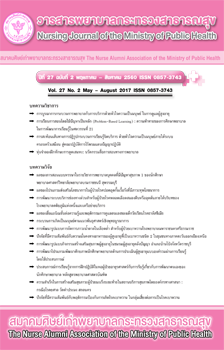การพัฒนาระบบบริการช่องทางด่วนสำหรับผู้ป่วยโรคหลอดเลือดสมองตีบหรืออุดตันภายใต้บริบทของโรงพยาบาลตติยภูมิแห่งหนึ่งและเครือข่ายบริการ
Main Article Content
บทคัดย่อ
บทคัดย่อ
การวิจัยเชิงปฏิบัติการแบบมีส่วนร่วมมีวัตถุประสงค์เพื่อพัฒนาระบบบริการช่องทางด่วนสำหรับผู้ป่วยโรคหลอดเลือดสมองตีบหรืออุดตันภายใต้บริบทของโรงพยาบาลตติยภูมิแห่งหนึ่งและเครือข่ายบริการกลุ่มเป้าหมายประกอบด้วย 4 กลุ่มคือ 1) เวชระเบียนของผู้ป่วยโรคหลอดเลือดสมองตีบหรืออุดตัน 2) ผู้ป่วยโรคหลอดเลือดสมองตีบหรืออุดตัน 3) ผู้ดูแลผู้ป่วย และ 4) พยาบาลผู้จัดการรายกรณีดำเนินการวิจัยระหว่างเดือนกรกฎาคมพ.ศ. 2556 ถึง กันยายนพ.ศ. 2558ดำเนินการใน 3 ระยะคือ 1) วิเคราะห์สถานการณ์ 2) พัฒนาระบบบริการและ 3) ประเมินผลเครื่องมือเก็บรวบรวมข้อมูล ประกอบด้วยแบบบันทึกข้อมูลผู้ป่วยแบบประเมินการปฏิบัติตามแนวทางการดูแลผู้ป่วยแนวทางการสัมภาษณ์ผู้ดูแลผู้ป่วย และแนวทางการสนทนากลุ่มวิเคราะห์ข้อมูลด้วยสถิติเชิงพรรณนาและการวิเคราะห์เนื้อหา
ผลการวิจัย:ระยะวิเคราะห์สถานการณ์พบปัญหาการบริการทั้งด้านกระบวนการและผลลัพธ์ระยะ พัฒนาระบบบริการได้มีกระบวนการพัฒนา 3 วงจร เกี่ยวกับ 1) การเข้าถึงบริการช่องทางด่วนที่รวดเร็ว 2) การคัดกรองผู้ป่วย 3) กระบวนการดูแลผู้ป่วยโดยทีมสหสาขาวิชาชีพ 4) การให้คำปรึกษา 5) การพัฒนาแนวทางการดูแลผู้ป่วยแนวปฏิบัติการพยาบาล และเครื่องมือการส่งต่อและ 6) การติดตามผู้ป่วยและประเมินผลลัพธ์ระยะประเมินผลพบว่าทีมสหสาขาวิชาชีพมีการปฏิบัติตามแนวทางการดูแลผู้ป่วย ร้อยละ 100 ระยะเวลาเฉลี่ยตั้งแต่ผู้ป่วยมาถึงโรงพยาบาลจนได้รับยาละลายลิ่มเลือด rt-PA ลดลงจาก 67.17 นาที เป็น 46.79 นาที จำนวนผู้ป่วยโรคหลอดเลือดสมองตีบหรืออุดตันที่ได้รับยาละลายลิ่มเลือด rt-PA ภายใน 60 นาที เพิ่มขึ้นจาก 9.26% เป็น 30.63% และไม่พบภาวะแทรกซ้อน ได้แก่ ปอดอักเสบจากการสำลัก แผลกดทับ และการพลัดตกหกล้มเกิดขึ้น ผู้ป่วยมีอาการดีขึ้นร้อยละ 70.5 ผลการศึกษาชี้ให้เห็นว่า ระบบบริการช่องทางด่วนสำหรับผู้ป่วยโรคหลอดเลือดสมองตีบหรืออุดตันที่พัฒนาขึ้นช่วยให้ผู้ป่วยได้ รับการดูแลรักษาอย่างรวดเร็วและตามมาตรฐาน
Development of Fast Track Service System for Patients with Ischemic Stroke in the Context of a Tertiary Care Hospital and Service Network
Ratanaporn Yontrakul*
Nisakorn Vibulchai**
Wiriporn Pinnadilay*
Julintorn Sripontun*
Benjaphon Aengwanich*
Abstract
This mutual collaborative action research study aimed to develop a fast track service system for patients with ischemic stroke in the context of a tertiary care hospital and service network. Target groups consisted of four groups: 1) data record forms for ischemic stroke 2) ischemic stroke patients 3) caregivers, and 4) nurse case managers. Data collection was conducted from July 2013 to September 2015. The study process was composed of three phases: 1) situational analysis, 2) service process development, and 3) evaluation. Research instruments included the data record form for ischemic stroke, an evaluation form for practice related to the standard care pathway, questions for interviewing caregivers, and questions for focus groups. Data were analyzed by descriptive statistics and content analysis.
Results: Situational analysis phase: problems of fast track service were reported in both process and outcome domains. Development phase: three action research cycles were as follow: 1) rapid access to stroke fast track 2) patient screening 3) care process by a multidisciplinary team; 4) consulting system 5) development of a standard care pathway, clinical nursing practice guideline, and referral tools, and 6) patient follow up and outcome evaluation. Evaluation phase: 100% of multidisciplinary team members followed the standard care pathway. Average duration of door to rt-PA decreased from 67.17 to 46.79 minutes. Ischemic stroke patients receiving rt-PA within 60 minutes increased from 9.26 % to 30.63%. There were no complications related to aspiration pneumonia, pressure sores, and falls. 70.5% of patients had an improvement in stroke outcomes. The results indicate that the developed fast track service system for patients with ischemic stroke helps with decreasing duration of access to the specialized are that these patients require.
*Mahasarakham Hospital
**Srimahasarakham Nursing College
Article Details
บทความและรายงานวิจัยในวารสารพยาบาลกระทรวงสาธารณสุข เป็นความคิดเห็นของ ผู้เขียน มิใช่ของคณะผู้จัดทำ และมิใช่ความรับผิดชอบของสมาคมศิษย์เก่าพยาบาลกระทรวงสาธารณสุข ซึ่งสามารถนำไปอ้างอิงได้
เอกสารอ้างอิง
2. Bureau of Policy and Strategy. Public Health Statistics A.D. 2014.Nonthaburi:Office of the Permanent Secretary,Ministry of Public Health; 2015.(in Thai).
3. Thomas T, Stephen B, Colin M. The global burden of cerebrovascular disease. [cited 2016 July 3]. Available from: http://www.who.int/healthinfo/statistics/bod_cerebrovasculardiseas estroke.pdf
4. Grysiewicz RA, Thomas K, Pandey DK. Epidemiology of ischemic and hemorrhagic stroke: incidence, prevalence, mortality, and risk factors. NeurolClin 2008;26:871-95.
5. Feigin VL, Lawes CM, Bennett DA, Anderson CS. Stroke epidemiology: a review of population-based studies of incidence, prevalence, and case-fatality in the late 20th century. Lancet Neurol2003; 2:43-53.
6. The Working Group of Fast Track System Development for Trauma, Coronary Artery Disease-Stroke,Region 12. Manual of patient care standards in fast track system for health care providers, Region 12.KhonKaen: Pen Printing
Company; 2012. (in Thai).
7. Jauch EC, Saver JL, Adams HP Jr, Bruno A, Connors JJ, Demaerschalk BM, et al. Guidelines for the early management of patients with acute ischemic stroke: a guideline for healthcare professionals from the American Heart
Association/American Stroke Association. Stroke 2013;44:870-947.
8. American Heart association/American Stroke Association.Target: stroke campaign manual. American Heart Association;2014.
9. Nualnetr N, Wannapong S, Khama S. Perception of stroke fast track among risk persons in community.Srinagarind Med J 2015;30:57-63. (in Thai).
10. Promtee P.Development of a fast track of care for stroke patients: An application of a case management model. Journal of Health Science 2014;23:313-22. (in Thai).
11. Kelly-Hayes M, Beiser A, Kase CS, Scaramucci A, D’Agostino RB, Wolf PA. The influence of gender and age on disability following ischemic stroke: the Framingham study. J Stroke Cerebrovasc Dis 2003;12:119-26.
12. Mahasarakham Hospital. The annual statistics report 2014. Mahasarakham: Mahasarakham Hospital; 2014. (in Thai).
13. Mahasarakham Hospital. Stroke fast track: Group discussion report 2012 Mahasarakham:Mahasarakham Hospital; 2012. (in Thai).
14. Thosingha O. Nursing case management: Models andmethods for implementation in hospital.In W.Pichitpornchai and U.Asdornwised (Eds.).Nursing case management. Bangkok: Niyomwitaya;2002:61-7. (in Thai).
15. Kemmis S, McTaggart R (eds.). The action research planner. Victoria, Australia: Deakin University Press;1988.
16. Tiamkao S.Development of stroke fast track network.Srinagarind Med J 2013; 28 (suppl): 315-9.(in Thai).
17. Kachataya J, Pitpreeyasaksakul C, Suksamphan S.Caring system development to care for patients with ST-Segment Elevation Myocardial Infarction (STEMI) receiving Primary Percutaneous Coronary Intervention at Phrapokklao Hospital, Thailand.Nursing Journal of the Ministry of Public Health 2014;24:136-48. (in Thai).

